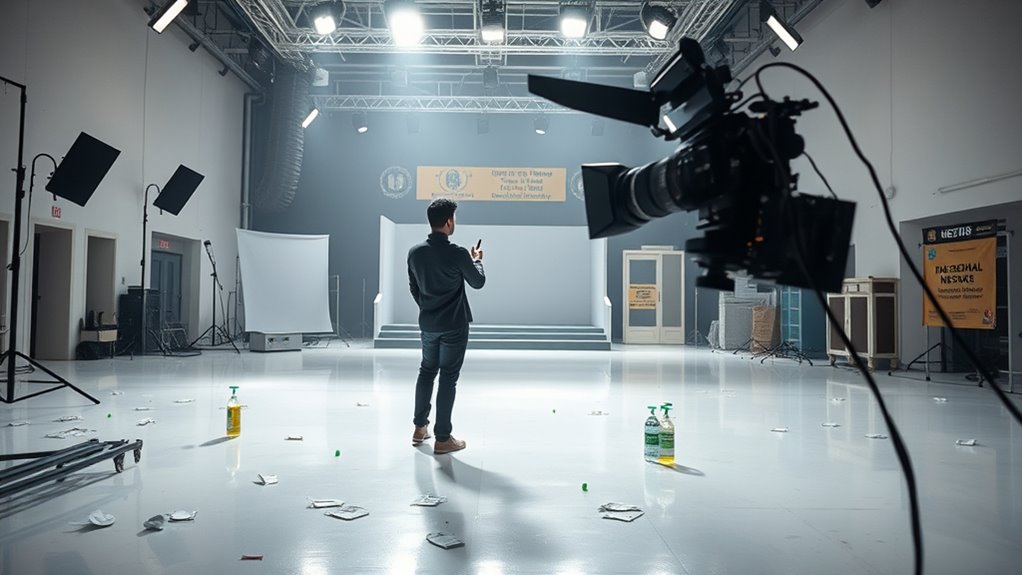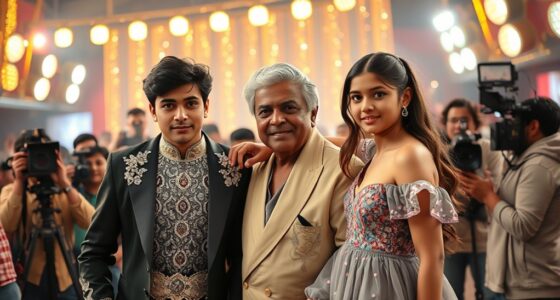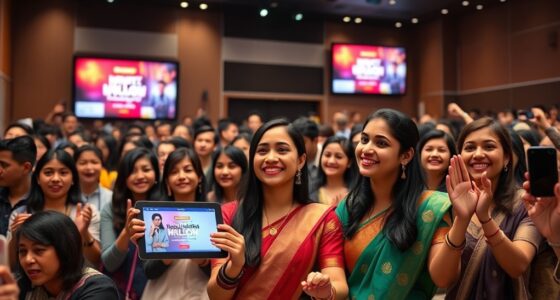COVID-19 has forever changed Bollywood’s shooting schedules by imposing strict safety protocols, leading to delays, higher costs, and shorter filming windows. Filmmakers now rely more on digital tools for planning and communication, while safety measures like social distancing and testing add new complexities. These shifts have made schedules more flexible but also more demanding. To understand how the industry is adjusting for the long term, explore what’s next for Bollywood’s filmmaking landscape.
Key Takeaways
- Shooting schedules faced significant delays due to safety protocols and COVID-19 testing requirements.
- Filmmakers shifted to digital workflows, reducing in-person meetings and adopting virtual collaboration tools.
- Safety measures like social distancing and sanitization increased production costs and extended filming timelines.
- Limited crew sizes and fewer actors on set led to reimagined scenes and more flexible shooting plans.
- The industry is now more safety-conscious and tech-integrated, permanently altering traditional Bollywood filming practices.

The COVID-19 pandemic has profoundly disrupted Bollywood’s shooting schedules, forcing filmmakers and actors to adapt quickly to new safety protocols and unpredictable delays. One of the biggest challenges has been dealing with digital disruptions. As in-person filming came to a halt, the industry turned to virtual tools and online collaborations to keep projects moving. You might have noticed how directors and actors now rely heavily on digital platforms for script readings, meetings, and even pre-visualization work. This swift shift to digital workflows was necessary but also introduced new hurdles. Technical glitches, connectivity issues, and the steep learning curve of unfamiliar technology slowed down production timelines. Despite these setbacks, the industry embraced this digital transformation, realizing it’s a crucial part of future filmmaking. Hybrid/Combination Units have emerged as an innovative solution to integrate multiple technologies for more flexible and efficient filming processes.
Safety protocols have become the backbone of every shoot. You’re likely aware that strict guidelines—like social distancing, regular sanitization, and health screenings—are now standard. These protocols reduce contact and help prevent outbreaks on set, but they also complicate the logistics of filming. For example, fewer actors can be on set at once, and scenes requiring large crowds are now replaced with creative solutions. Crew members wear masks and gloves constantly, which can hinder communication and affect the natural flow of scenes. Additionally, testing for COVID-19 has become a routine part of production schedules, often causing delays when positive cases emerge. These safety measures, while essential, add layers of complexity to a process that was already demanding. The increased emphasis on health safety has led to the adoption of specialized air purification and filtration systems on sets to improve air quality, ensuring a safer environment for everyone involved.
You’ve probably observed how these protocols have extended shooting timelines and increased costs. Sometimes, scenes are rescheduled or reimagined to comply with safety rules, which can push back release dates. The need for shorter shooting windows and limited crew sizes has also led to more efficient but sometimes more stressful work environments. Filmmakers now have to balance creativity with safety, often making on-the-fly adjustments to scripts and scenes. Despite the hurdles, the industry’s resilience shines through as everyone works to keep productions safe and functional. These adaptations, driven by digital disruptions and rigorous safety protocols, have permanently changed how Bollywood approaches filmmaking. Moving forward, you can expect even more integration of technology and safety-first practices, shaping a new era of cinema that’s more flexible, tech-savvy, and safety-conscious.
Frequently Asked Questions
How Have Actors’ Personal Lives Been Affected by Schedule Changes?
You’ve felt the impact of schedule changes through personal sacrifices and relationship strains. With longer shoots and unpredictable timelines, you might miss important family moments or social gatherings. These disruptions can lead to emotional stress, affecting your personal life. Despite the challenges, many actors adapt by prioritizing what matters most, learning to balance their demanding careers with their personal well-being, even amid ongoing uncertainties.
What New Safety Protocols Are Now Standard on Sets?
On sets now, you’ll notice strict safety protocols like enhanced set sanitation to prevent virus spread. Vaccination mandates are standard, ensuring everyone is protected before filming begins. You’re expected to follow social distancing rules, wear masks when not on camera, and use sanitizers frequently. These measures create a safer environment, allowing filming to continue smoothly while prioritizing everyone’s health. Staying compliant helps keep Bollywood productions running safely in these times.
How Has Remote Filming Impacted Traditional Production Techniques?
You might think remote filming would hinder, but it’s actually boosted traditional production techniques through virtual collaboration. You now see technology integration in every scene, allowing crews to adapt quickly and efficiently. Ironically, the move to remote setups has made Bollywood productions more flexible, connecting talent across distances like never before. This shift challenges old norms, proving that even in filmmaking, distance can bring us closer together through innovation.
Are There Financial Incentives for Producers to Adapt New Schedules?
You’ll find that producers now have financial incentives to adapt new schedules, like insurance benefits and tax incentives, which help offset risks and costs. These benefits encourage you to explore flexible shooting plans, reducing delays and expenses. By leveraging such incentives, you can make productions more economical and resilient, turning challenges into opportunities for innovation and efficiency in your filmmaking process.
How Do International Collaborations Fit Into Post-Pandemic Schedules?
You might think international collaborations simplify schedules, but they actually add cross-border partnerships and scheduling complexities. Post-pandemic, filmmakers juggle different time zones, travel restrictions, and varied protocols, making planning tougher. Yet, these collaborations also open doors to new talent and markets. You’ll find that balancing these factors requires flexibility, strategic planning, and clear communication, ensuring projects stay on track despite the logistical hurdles posed by international partnerships.
Conclusion
As you watch Bollywood films now, you can’t help but wonder—what changes will stick around forever? The pandemic has reshaped shooting schedules in ways you never imagined, and the future remains uncertain. Will new safety protocols become the norm? Or will everything eventually return to the old ways? One thing’s for sure: Bollywood’s filmmaking journey has taken a dramatic turn, and only time will reveal what’s next in this ever-evolving industry.









